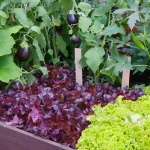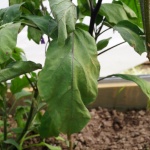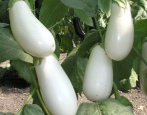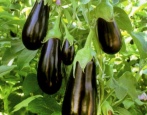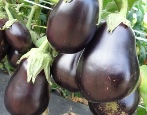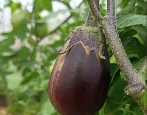
- Authors: Katarzhin M.S. (Volgograd Experimental Station of the All-Russian Research Institute of Plant Growing)
- Year of approval: 1966
- Growth type: vigorous
- Bush height, cm: 73-90
- Fruit shape: cylindrical
- Fruit weight, g: 123-175
- Yield: high yielding
- Keeping quality: excellent
- Transportability: excellent
- Ripening terms: mid-early
Not knowing which type of eggplant to choose for planting in the garden or in the greenhouse, you should pay attention to proven varieties with a long history. These are the mid-early variety Universal 6, endowed with good stress resistance.
Description of the variety
Eggplant Universal 6 is a variety that was bred more than 50 years ago at the Volgograd experimental station of the V.I. N.I. Vavilov in 1962. The authorship belongs to the well-known breeder Katarzhin M.S. The vegetable is cultivated in the North Caucasian and Lower Volga regions. According to experienced vegetable growers, the most productive culture, growing in the Crimea and the Krasnodar Territory. Eggplant can be grown in garden beds, in greenhouse structures, and under a film.
Characteristics of the appearance of plants and fruits
This variety is a vigorous plant that, in favorable conditions, stretches up to 90 cm in height. The compact shrub is characterized by non-sprawling branches, medium leafiness with bright green foliage, which protects from the sun, a powerful central stem of greenish-brown color with slight pubescence, as well as a rare thorny calyx. It is worth noting that the culture needs pollination. During flowering, large purple flowers appear on the plants. On average, up to 12-13 neat specimens ripen on an eggplant bush.
The station wagon 6 is a representative of medium-fruit vegetables. As a rule, vegetables weighing less than 200 grams (123-175) grow on the bushes. The length of the eggplant reaches 18-19.5 cm with a diameter of up to 6 cm. The shape of the fruit is cylindrical or elongated-clavate, with a curved end. The surface of the eggplant is smooth, with a pronounced shine and a uniform dark purple color at absolute ripeness. An unripe vegetable has a washed-out brown-yellow color, diluted with brown inserts. The peel of the fruit is thin, but elastic and firm.
Ripe eggplants can easily be transported, and can also be stored for up to 20-25 days in a cool and dry basement. It is important that vegetables that are planned to be stored for a long time are properly removed from the bushes and not damaged.
Purpose and taste
The vegetable has a classic taste. The yellowish-white flesh is endowed with a fleshy, moderately dense and slightly friable consistency without fibrillation and voids. The taste of eggplants is pleasant, slightly oily, without bitterness and astringency. Eggplant pulp contains many seeds, but they are very small.
Ripe vegetables can be fried, stewed, pickled, frozen, baked, and canned. Ideal for processing into caviar.
Ripening terms
Station wagon 6 belongs to the category of mid-early varieties. The growing season lasts up to 130 days. The fruiting period is slightly extended. Mass production of fruits occurs in July-August. It is recommended to remove ripe eggplants every 5-6 days so that other specimens have the opportunity to ripen.
Yield
The variety is declared as high-yielding.Taking care of the plant, you can count on a return of up to 6.5 kg / m2.
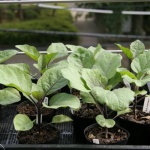
To get a tasty and bountiful eggplant crop, you must first grow strong and healthy seedlings. This culture is considered very capricious, therefore, you need to take care of seedlings when growing at home as correctly and carefully as possible.
Landing scheme
When planning the planting of eggplant bushes, do not forget about the intricacies of cultivation: density and keeping the distance between plantings. It is recommended to plant 4-5 bushes per 1 m2. Landing is carried out according to the classic 40x60 cm scheme.
Growing and care
The vegetable culture is grown by the seedling method. Sowing seeds for seedlings is carried out in February, and transplanting bushes to a permanent place of growth - in the second half of May, sometimes in early June.
Crop care consists of basic activities: regular irrigation with warm water under the root, fertilization 3-4 times per season, weeding and loosening of the soil every 10-12 days, which improves the penetration of moisture and air to the roots of the plant, the formation of a bush in 1-3 stalk, garter to supports, removal of excess lateral processes, laying a layer of mulch in the aisles at will, prevention of viruses, as well as ventilation in greenhouses.
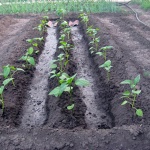
Planting eggplant is one of the most important stages in growing. When choosing a place for eggplants on your site, it is important to remember that this culture should be in warm soil, constantly illuminated by the sun. The plant is also very fond of spacious, open spaces, since its roots can grow over sufficient areas.
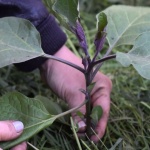

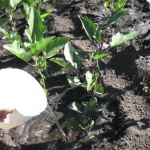
Soil requirements
Eggplants Universal 6, like most of their relatives, prefer loose, light, fertile and breathable soils with good moisture permeability and neutral acidity. You should not plant a vegetable in swampy and acidic soils.
Required climatic conditions
This variety has a high resistance to stress, therefore it tolerates periods of drought and extreme heat well. In addition, the plant is resistant to minor temperature fluctuations, but eggplants will grow comfortably in sunny areas, where there is a lot of light and heat, and there is a barrier from drafts.
Disease and pest resistance
Due to its good immunity, the culture is resistant to a number of diseases. The exceptions are verticillium and fusarium wilting, to which the eggplant is moderately susceptible.

Eggplant is one of the most demanding crops. For its successful cultivation, it is necessary to create optimal conditions, as well as to carry out prevention and fight against diseases and pests. Eggplant often infects both fungal and viral diseases. If treatment is not started on time, you can completely lose the crop.





